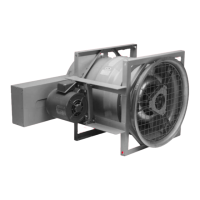Installation
RRU-SVX02F-EN 25
Controls Using 24 Vac
Before installing any connecting wiring, refer to Figure 2,
p. 14 and Figure 3, p. 14 for the electrical access locations
provided on the unit and Table 2 for AC conductor sizing
guidelines, and;
1. Use copper conductors unless otherwise specified.
2. Ensure that the AC control wiring between the controls
and the unit’s termination point does not exceed three
(3) ohms/ conductor for the length of the run.
Note: Resistance in excess of 3 ohms per conductor
may cause component failure due to
insufficient AC voltage supply.
3. Be sure to check all loads and conductors for grounds,
shorts, and mis-wiring.
4. Do not run the AC low voltage wiring in the same
conduit with the high voltage power wiring.
Controls using DC Analog Input/
Output (Standard Low Voltage
Multiconductor Wire)
Before installing any connecting wiring between the unit
and components utilizing a DC analog input\output signal,
refer to Figure 2, p. 14 and Figure 3, p. 14 for the electrical
access locations provided on the unit.
1. Table 3, p. 25 lists the conductor sizing guidelines that
must be followed when interconnecting the DC binary
output devices and the system components utilizing a
DC analog input\output signal to the unit.
Note: Resistance in excess of 2.5 ohms per conductor
can cause deviations in the accuracy of the
controls.
2. Ensure that the wiring between controls and the unit’s
termination point does not exceed two and a half (2.5)
ohms/conductor for the length of the run.
a. Do not run the electrical wires transporting DC
signals in or around conduit housing high voltage
wires.
DC Conductors
NOTICE
Use Copper Conductors Only!
Failure to use copper conductors could result in
equipment damage as the equipment was not designed
or qualified to accept other types of conductors.
Table 2. 24V AC conductors
Distance from Unit to
Control
Recommended Wire
Size
000–460 feet 18 gauge
000–140 m 0.75 mm
2
461–732 feet 16 gauge
WARNING
Hazardous Voltage w/Capacitors!
Failure to disconnect power and discharge capacitors
before servicing could result in death or serious injury.
Disconnect all electric power, including remote
disconnects and discharge all motor start/run
capacitors before servicing. Follow proper lockout/
tagout procedures to ensure the power cannot be
inadvertently energized. Verify with an appropriate
voltmeter that all capacitors have discharged.
Table 3. Zone sensor module wiring
Distance from Unit to
Control
Recommended Wire
Size
000–150 feet
0–45.7 m
22 gauge
0.33 mm
2
151–240 feet
46–73.1 m
20 gauge
0.50 mm
2
241–385 feet
73.5–117.3 m
18 gauge
0.75 mm
2
386–610 feet
117.7–185.9 m
16 gauge
1.3 mm
2
611–970 feet
186.2–295.7 m
14 gauge
2.0 mm
2

